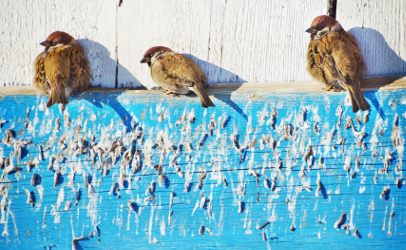Birds are a beautiful thing of nature and should be respected and admired. However, they do not belong inside foodservice operations or any other food facilities. Their search for food and a comfortable harborage area, especially now during the colder months, encourages birds to seek entry to the great indoors. The possibility of contamination from such incursions is why health officials deem them “critical” food safety violations.  Birds can be the source of many pathogenic microorganisms, including Campylobacter, E. coli, Listeria and Salmonella. The potential transfer of fecal matter is the problem, whether it is directly on/in food products, equipment or water sources. Foodservice establishments should be proactive when it comes to bird control. Eliminating harborage areas begins with a bird’s eye view of a building’s exterior. Old or unused equipment stored for an extended period of time outdoors has a tendency to create a pleasant roosting area, especially when it rains or melting snow pools, making a lovely bathing area. Poor sanitation practices and improper refuse disposal can combine with what is stored outside to make an even more attractive habitat. If you are going to keep an uncovered pallet of seed outside, you may just be sending an invitation to the whole flock. Nesting areas should be removed and receiving doors should be kept closed if there are no plastic air curtain strips. Fixing holes and other entry points and having bird deterrents are also part of a solid integrated pest management system. You should also keep tabs on your customers and neighbors. Are they feeding the birds on your property? Check your deliveries for bird infestation as well — issues could be coming in with products. If a bird does get into the interior of a building it should be removed humanely, with a net or trap or corralled out to the exterior, not executed. Sometimes just leaving the door open will do the trick. I have seen some interesting things in regard to bird infestation. Poop directly on produce, in processed food and on product packaging, not to mention the bottom of my shoes from excessive geese manure accumulation by the Hudson River. That’s the last thing I need to track on to the living room rug where it could expose the kids, or the dog for that matter, to pathogens. A buildup of bird droppings on signs, walls, windows and other non-food contact surfaces sends an unsanitary message to your employees, customers and anyone else taking a look around. I have also witnessed birds feeding on rice in a retail store, then drinking water from refrigeration condensation. Nothing like a little food, beverage and a show. Birds also have a sixth sense when they feel threatened and change their activity pattern accordingly. Some get wise to their surroundings, others become confused and panicked when confined. So, you have to ask yourself the next time any big city pigeon or neighborhood sparrow blesses your shoulder or head with a well-aimed, watery, pathogen-laden, multi-colored gift — am I really lucky? (To sign up for a free subscription to Food Safety News, click here.)
Birds can be the source of many pathogenic microorganisms, including Campylobacter, E. coli, Listeria and Salmonella. The potential transfer of fecal matter is the problem, whether it is directly on/in food products, equipment or water sources. Foodservice establishments should be proactive when it comes to bird control. Eliminating harborage areas begins with a bird’s eye view of a building’s exterior. Old or unused equipment stored for an extended period of time outdoors has a tendency to create a pleasant roosting area, especially when it rains or melting snow pools, making a lovely bathing area. Poor sanitation practices and improper refuse disposal can combine with what is stored outside to make an even more attractive habitat. If you are going to keep an uncovered pallet of seed outside, you may just be sending an invitation to the whole flock. Nesting areas should be removed and receiving doors should be kept closed if there are no plastic air curtain strips. Fixing holes and other entry points and having bird deterrents are also part of a solid integrated pest management system. You should also keep tabs on your customers and neighbors. Are they feeding the birds on your property? Check your deliveries for bird infestation as well — issues could be coming in with products. If a bird does get into the interior of a building it should be removed humanely, with a net or trap or corralled out to the exterior, not executed. Sometimes just leaving the door open will do the trick. I have seen some interesting things in regard to bird infestation. Poop directly on produce, in processed food and on product packaging, not to mention the bottom of my shoes from excessive geese manure accumulation by the Hudson River. That’s the last thing I need to track on to the living room rug where it could expose the kids, or the dog for that matter, to pathogens. A buildup of bird droppings on signs, walls, windows and other non-food contact surfaces sends an unsanitary message to your employees, customers and anyone else taking a look around. I have also witnessed birds feeding on rice in a retail store, then drinking water from refrigeration condensation. Nothing like a little food, beverage and a show. Birds also have a sixth sense when they feel threatened and change their activity pattern accordingly. Some get wise to their surroundings, others become confused and panicked when confined. So, you have to ask yourself the next time any big city pigeon or neighborhood sparrow blesses your shoulder or head with a well-aimed, watery, pathogen-laden, multi-colored gift — am I really lucky? (To sign up for a free subscription to Food Safety News, click here.)
Sponsored by Marler Clark
